Machine Learning in the Era of Digital Health: Research Analysis
VerifiedAdded on 2023/06/03
|16
|6892
|322
Report
AI Summary
This report provides a comprehensive overview of machine learning's role in the digital health era. It defines digital health and its evolution, emphasizing the integration of technology to improve healthcare services. The report explores the application of machine learning in healthcare, highlighting its benefits in areas such as service delivery, diagnostics, and treatment planning. It delves into the challenges of implementing machine learning, including data complexity, ethical considerations, and the need for human oversight. The report analyzes the acceptance rate of machine learning among healthcare stakeholders and identifies future roles for machine learning within the digital health system. It also discusses various machine learning techniques and their potential impact on healthcare outcomes, including the potential for improved patient care and reduced costs. The report concludes with a discussion on the significance of machine learning in transforming healthcare, emphasizing the need for continuous research and development to maximize its benefits while addressing its challenges.
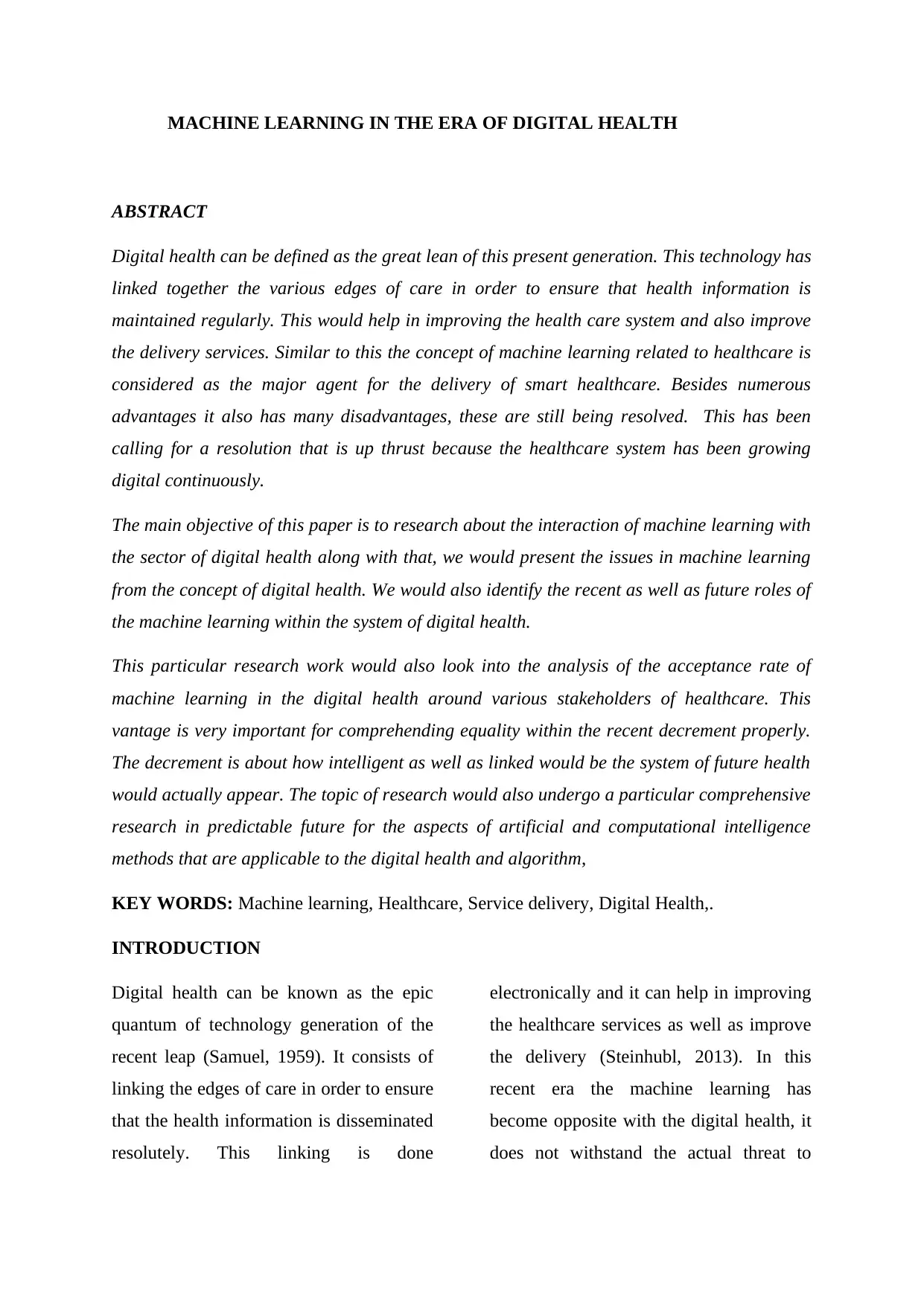
MACHINE LEARNING IN THE ERA OF DIGITAL HEALTH
ABSTRACT
Digital health can be defined as the great lean of this present generation. This technology has
linked together the various edges of care in order to ensure that health information is
maintained regularly. This would help in improving the health care system and also improve
the delivery services. Similar to this the concept of machine learning related to healthcare is
considered as the major agent for the delivery of smart healthcare. Besides numerous
advantages it also has many disadvantages, these are still being resolved. This has been
calling for a resolution that is up thrust because the healthcare system has been growing
digital continuously.
The main objective of this paper is to research about the interaction of machine learning with
the sector of digital health along with that, we would present the issues in machine learning
from the concept of digital health. We would also identify the recent as well as future roles of
the machine learning within the system of digital health.
This particular research work would also look into the analysis of the acceptance rate of
machine learning in the digital health around various stakeholders of healthcare. This
vantage is very important for comprehending equality within the recent decrement properly.
The decrement is about how intelligent as well as linked would be the system of future health
would actually appear. The topic of research would also undergo a particular comprehensive
research in predictable future for the aspects of artificial and computational intelligence
methods that are applicable to the digital health and algorithm,
KEY WORDS: Machine learning, Healthcare, Service delivery, Digital Health,.
INTRODUCTION
Digital health can be known as the epic
quantum of technology generation of the
recent leap (Samuel, 1959). It consists of
linking the edges of care in order to ensure
that the health information is disseminated
resolutely. This linking is done
electronically and it can help in improving
the healthcare services as well as improve
the delivery (Steinhubl, 2013). In this
recent era the machine learning has
become opposite with the digital health, it
does not withstand the actual threat to
ABSTRACT
Digital health can be defined as the great lean of this present generation. This technology has
linked together the various edges of care in order to ensure that health information is
maintained regularly. This would help in improving the health care system and also improve
the delivery services. Similar to this the concept of machine learning related to healthcare is
considered as the major agent for the delivery of smart healthcare. Besides numerous
advantages it also has many disadvantages, these are still being resolved. This has been
calling for a resolution that is up thrust because the healthcare system has been growing
digital continuously.
The main objective of this paper is to research about the interaction of machine learning with
the sector of digital health along with that, we would present the issues in machine learning
from the concept of digital health. We would also identify the recent as well as future roles of
the machine learning within the system of digital health.
This particular research work would also look into the analysis of the acceptance rate of
machine learning in the digital health around various stakeholders of healthcare. This
vantage is very important for comprehending equality within the recent decrement properly.
The decrement is about how intelligent as well as linked would be the system of future health
would actually appear. The topic of research would also undergo a particular comprehensive
research in predictable future for the aspects of artificial and computational intelligence
methods that are applicable to the digital health and algorithm,
KEY WORDS: Machine learning, Healthcare, Service delivery, Digital Health,.
INTRODUCTION
Digital health can be known as the epic
quantum of technology generation of the
recent leap (Samuel, 1959). It consists of
linking the edges of care in order to ensure
that the health information is disseminated
resolutely. This linking is done
electronically and it can help in improving
the healthcare services as well as improve
the delivery (Steinhubl, 2013). In this
recent era the machine learning has
become opposite with the digital health, it
does not withstand the actual threat to
Paraphrase This Document
Need a fresh take? Get an instant paraphrase of this document with our AI Paraphraser
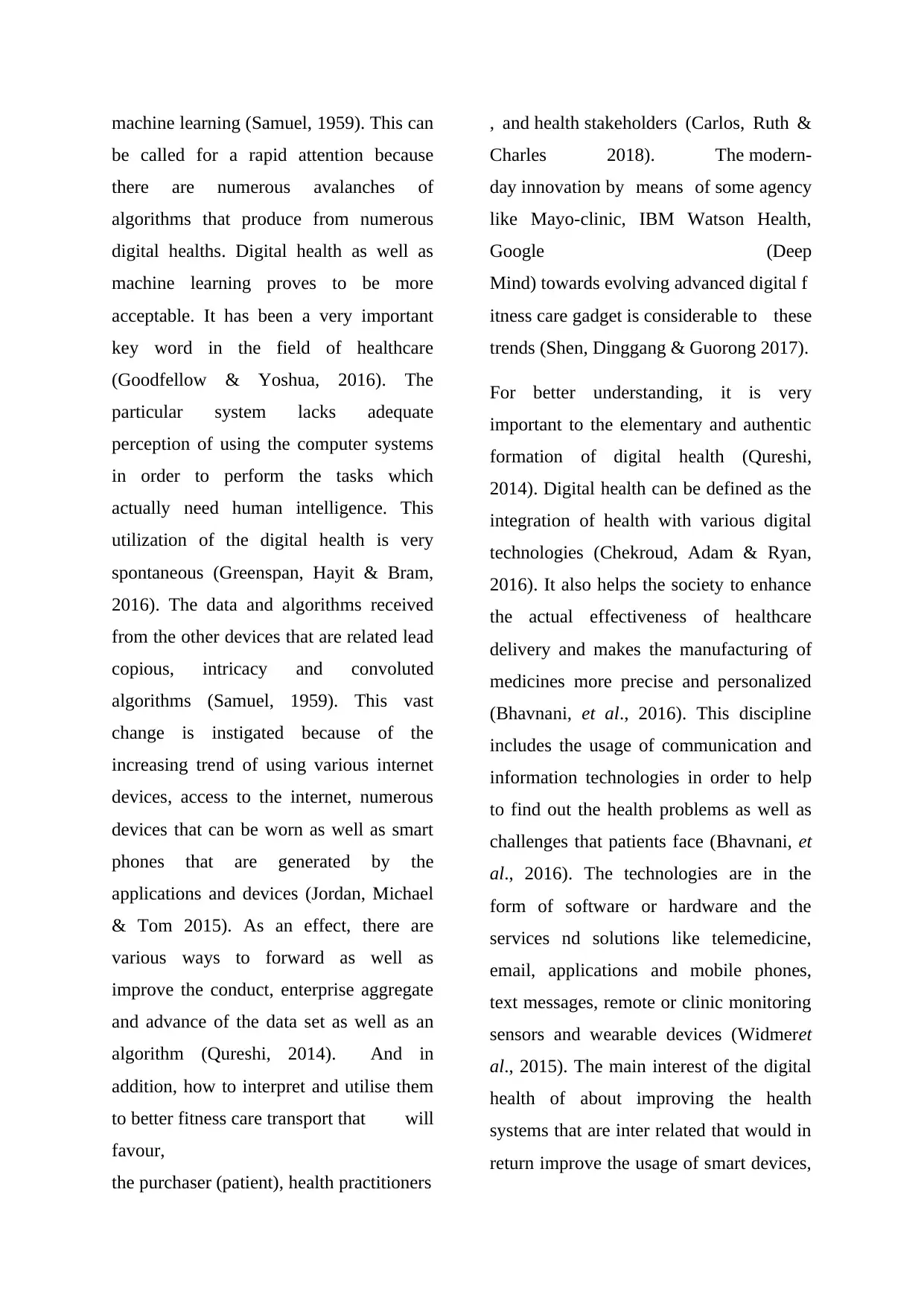
machine learning (Samuel, 1959). This can
be called for a rapid attention because
there are numerous avalanches of
algorithms that produce from numerous
digital healths. Digital health as well as
machine learning proves to be more
acceptable. It has been a very important
key word in the field of healthcare
(Goodfellow & Yoshua, 2016). The
particular system lacks adequate
perception of using the computer systems
in order to perform the tasks which
actually need human intelligence. This
utilization of the digital health is very
spontaneous (Greenspan, Hayit & Bram,
2016). The data and algorithms received
from the other devices that are related lead
copious, intricacy and convoluted
algorithms (Samuel, 1959). This vast
change is instigated because of the
increasing trend of using various internet
devices, access to the internet, numerous
devices that can be worn as well as smart
phones that are generated by the
applications and devices (Jordan, Michael
& Tom 2015). As an effect, there are
various ways to forward as well as
improve the conduct, enterprise aggregate
and advance of the data set as well as an
algorithm (Qureshi, 2014). And in
addition, how to interpret and utilise them
to better fitness care transport that will
favour,
the purchaser (patient), health practitioners
, and health stakeholders (Carlos, Ruth &
Charles 2018). The modern-
day innovation by means of some agency
like Mayo-clinic, IBM Watson Health,
Google (Deep
Mind) towards evolving advanced digital f
itness care gadget is considerable to these
trends (Shen, Dinggang & Guorong 2017).
For better understanding, it is very
important to the elementary and authentic
formation of digital health (Qureshi,
2014). Digital health can be defined as the
integration of health with various digital
technologies (Chekroud, Adam & Ryan,
2016). It also helps the society to enhance
the actual effectiveness of healthcare
delivery and makes the manufacturing of
medicines more precise and personalized
(Bhavnani, et al., 2016). This discipline
includes the usage of communication and
information technologies in order to help
to find out the health problems as well as
challenges that patients face (Bhavnani, et
al., 2016). The technologies are in the
form of software or hardware and the
services nd solutions like telemedicine,
email, applications and mobile phones,
text messages, remote or clinic monitoring
sensors and wearable devices (Widmeret
al., 2015). The main interest of the digital
health of about improving the health
systems that are inter related that would in
return improve the usage of smart devices,
be called for a rapid attention because
there are numerous avalanches of
algorithms that produce from numerous
digital healths. Digital health as well as
machine learning proves to be more
acceptable. It has been a very important
key word in the field of healthcare
(Goodfellow & Yoshua, 2016). The
particular system lacks adequate
perception of using the computer systems
in order to perform the tasks which
actually need human intelligence. This
utilization of the digital health is very
spontaneous (Greenspan, Hayit & Bram,
2016). The data and algorithms received
from the other devices that are related lead
copious, intricacy and convoluted
algorithms (Samuel, 1959). This vast
change is instigated because of the
increasing trend of using various internet
devices, access to the internet, numerous
devices that can be worn as well as smart
phones that are generated by the
applications and devices (Jordan, Michael
& Tom 2015). As an effect, there are
various ways to forward as well as
improve the conduct, enterprise aggregate
and advance of the data set as well as an
algorithm (Qureshi, 2014). And in
addition, how to interpret and utilise them
to better fitness care transport that will
favour,
the purchaser (patient), health practitioners
, and health stakeholders (Carlos, Ruth &
Charles 2018). The modern-
day innovation by means of some agency
like Mayo-clinic, IBM Watson Health,
Google (Deep
Mind) towards evolving advanced digital f
itness care gadget is considerable to these
trends (Shen, Dinggang & Guorong 2017).
For better understanding, it is very
important to the elementary and authentic
formation of digital health (Qureshi,
2014). Digital health can be defined as the
integration of health with various digital
technologies (Chekroud, Adam & Ryan,
2016). It also helps the society to enhance
the actual effectiveness of healthcare
delivery and makes the manufacturing of
medicines more precise and personalized
(Bhavnani, et al., 2016). This discipline
includes the usage of communication and
information technologies in order to help
to find out the health problems as well as
challenges that patients face (Bhavnani, et
al., 2016). The technologies are in the
form of software or hardware and the
services nd solutions like telemedicine,
email, applications and mobile phones,
text messages, remote or clinic monitoring
sensors and wearable devices (Widmeret
al., 2015). The main interest of the digital
health of about improving the health
systems that are inter related that would in
return improve the usage of smart devices,
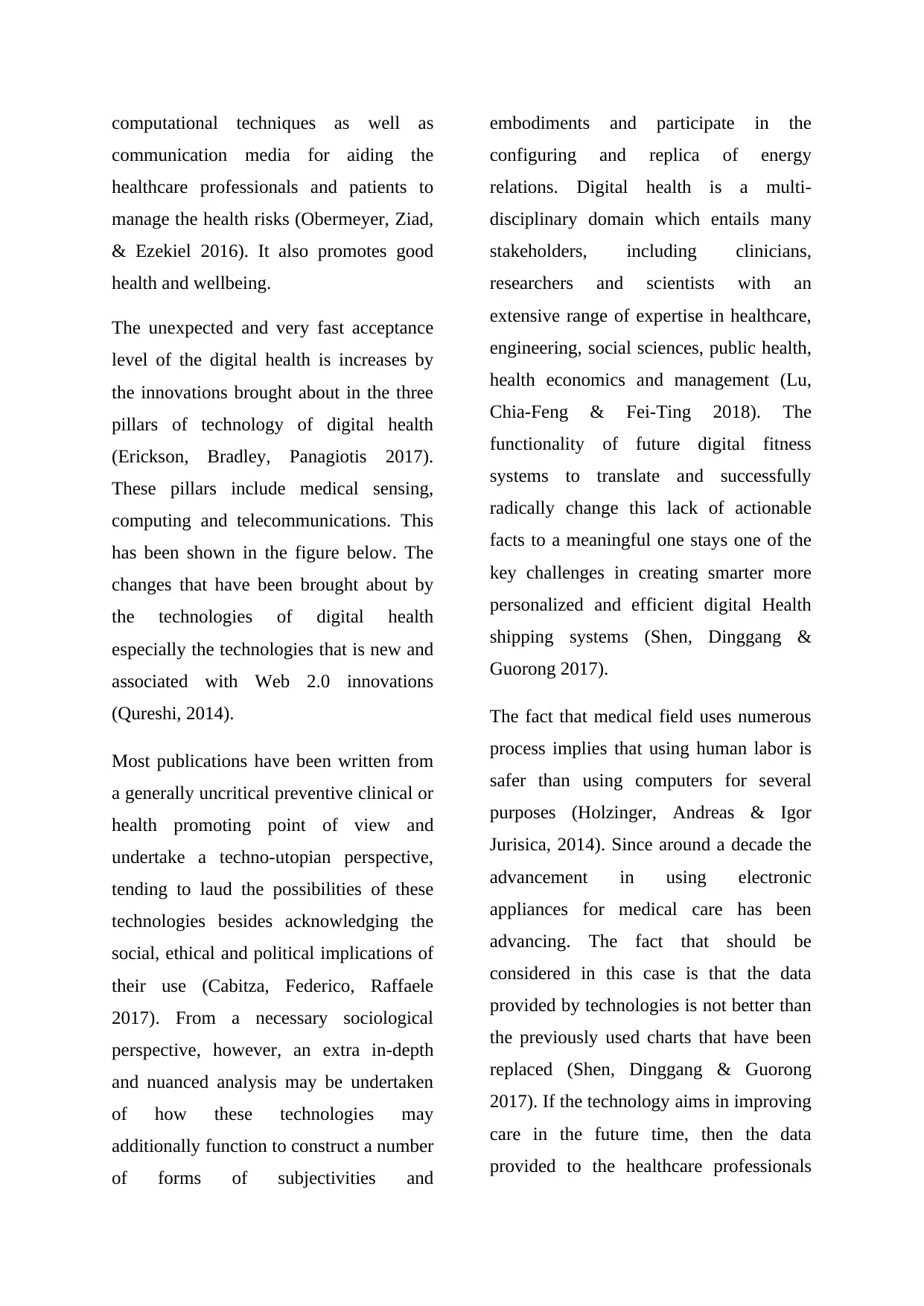
computational techniques as well as
communication media for aiding the
healthcare professionals and patients to
manage the health risks (Obermeyer, Ziad,
& Ezekiel 2016). It also promotes good
health and wellbeing.
The unexpected and very fast acceptance
level of the digital health is increases by
the innovations brought about in the three
pillars of technology of digital health
(Erickson, Bradley, Panagiotis 2017).
These pillars include medical sensing,
computing and telecommunications. This
has been shown in the figure below. The
changes that have been brought about by
the technologies of digital health
especially the technologies that is new and
associated with Web 2.0 innovations
(Qureshi, 2014).
Most publications have been written from
a generally uncritical preventive clinical or
health promoting point of view and
undertake a techno-utopian perspective,
tending to laud the possibilities of these
technologies besides acknowledging the
social, ethical and political implications of
their use (Cabitza, Federico, Raffaele
2017). From a necessary sociological
perspective, however, an extra in-depth
and nuanced analysis may be undertaken
of how these technologies may
additionally function to construct a number
of forms of subjectivities and
embodiments and participate in the
configuring and replica of energy
relations. Digital health is a multi-
disciplinary domain which entails many
stakeholders, including clinicians,
researchers and scientists with an
extensive range of expertise in healthcare,
engineering, social sciences, public health,
health economics and management (Lu,
Chia-Feng & Fei-Ting 2018). The
functionality of future digital fitness
systems to translate and successfully
radically change this lack of actionable
facts to a meaningful one stays one of the
key challenges in creating smarter more
personalized and efficient digital Health
shipping systems (Shen, Dinggang &
Guorong 2017).
The fact that medical field uses numerous
process implies that using human labor is
safer than using computers for several
purposes (Holzinger, Andreas & Igor
Jurisica, 2014). Since around a decade the
advancement in using electronic
appliances for medical care has been
advancing. The fact that should be
considered in this case is that the data
provided by technologies is not better than
the previously used charts that have been
replaced (Shen, Dinggang & Guorong
2017). If the technology aims in improving
care in the future time, then the data
provided to the healthcare professionals
communication media for aiding the
healthcare professionals and patients to
manage the health risks (Obermeyer, Ziad,
& Ezekiel 2016). It also promotes good
health and wellbeing.
The unexpected and very fast acceptance
level of the digital health is increases by
the innovations brought about in the three
pillars of technology of digital health
(Erickson, Bradley, Panagiotis 2017).
These pillars include medical sensing,
computing and telecommunications. This
has been shown in the figure below. The
changes that have been brought about by
the technologies of digital health
especially the technologies that is new and
associated with Web 2.0 innovations
(Qureshi, 2014).
Most publications have been written from
a generally uncritical preventive clinical or
health promoting point of view and
undertake a techno-utopian perspective,
tending to laud the possibilities of these
technologies besides acknowledging the
social, ethical and political implications of
their use (Cabitza, Federico, Raffaele
2017). From a necessary sociological
perspective, however, an extra in-depth
and nuanced analysis may be undertaken
of how these technologies may
additionally function to construct a number
of forms of subjectivities and
embodiments and participate in the
configuring and replica of energy
relations. Digital health is a multi-
disciplinary domain which entails many
stakeholders, including clinicians,
researchers and scientists with an
extensive range of expertise in healthcare,
engineering, social sciences, public health,
health economics and management (Lu,
Chia-Feng & Fei-Ting 2018). The
functionality of future digital fitness
systems to translate and successfully
radically change this lack of actionable
facts to a meaningful one stays one of the
key challenges in creating smarter more
personalized and efficient digital Health
shipping systems (Shen, Dinggang &
Guorong 2017).
The fact that medical field uses numerous
process implies that using human labor is
safer than using computers for several
purposes (Holzinger, Andreas & Igor
Jurisica, 2014). Since around a decade the
advancement in using electronic
appliances for medical care has been
advancing. The fact that should be
considered in this case is that the data
provided by technologies is not better than
the previously used charts that have been
replaced (Shen, Dinggang & Guorong
2017). If the technology aims in improving
care in the future time, then the data
provided to the healthcare professionals
⊘ This is a preview!⊘
Do you want full access?
Subscribe today to unlock all pages.

Trusted by 1+ million students worldwide
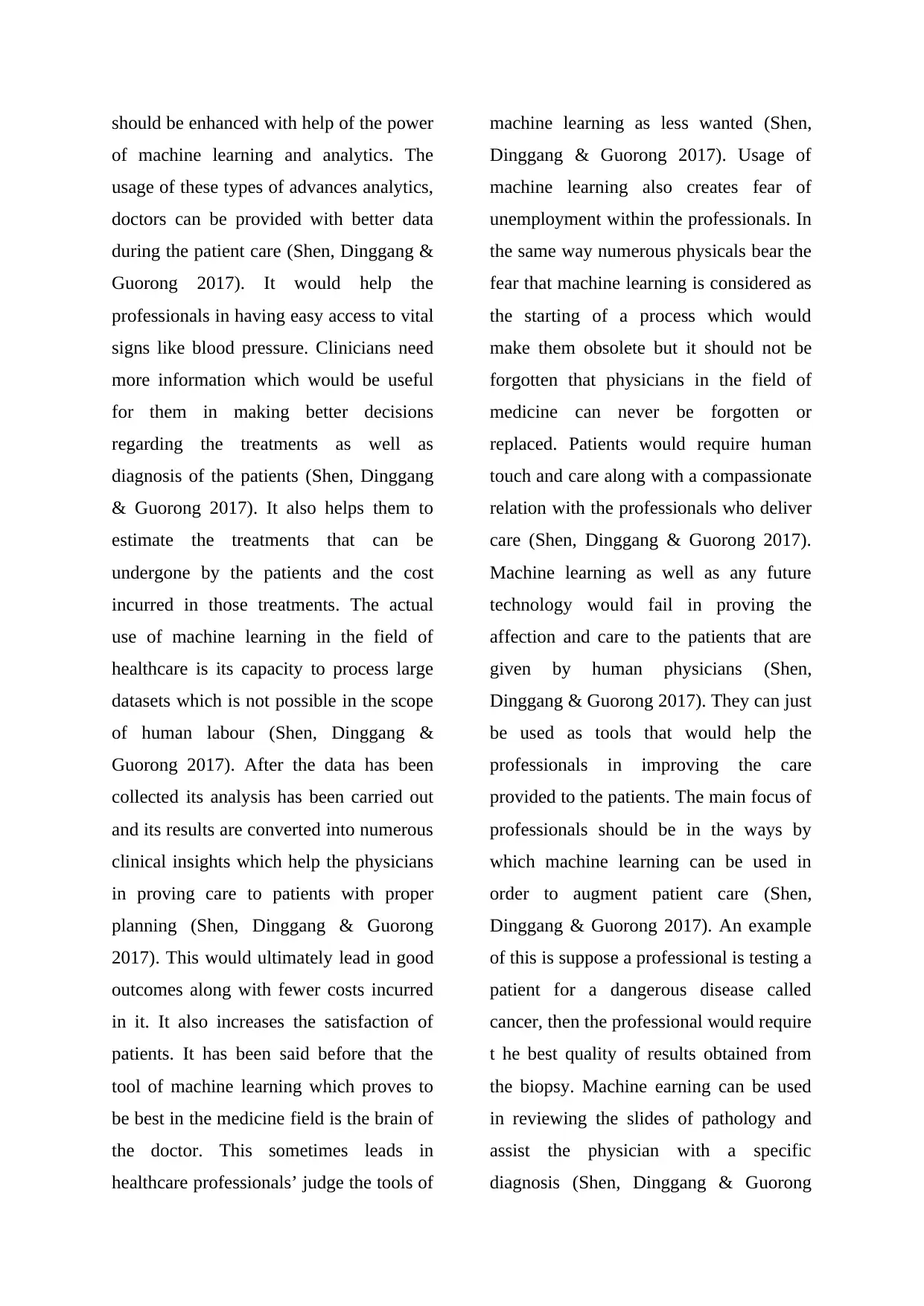
should be enhanced with help of the power
of machine learning and analytics. The
usage of these types of advances analytics,
doctors can be provided with better data
during the patient care (Shen, Dinggang &
Guorong 2017). It would help the
professionals in having easy access to vital
signs like blood pressure. Clinicians need
more information which would be useful
for them in making better decisions
regarding the treatments as well as
diagnosis of the patients (Shen, Dinggang
& Guorong 2017). It also helps them to
estimate the treatments that can be
undergone by the patients and the cost
incurred in those treatments. The actual
use of machine learning in the field of
healthcare is its capacity to process large
datasets which is not possible in the scope
of human labour (Shen, Dinggang &
Guorong 2017). After the data has been
collected its analysis has been carried out
and its results are converted into numerous
clinical insights which help the physicians
in proving care to patients with proper
planning (Shen, Dinggang & Guorong
2017). This would ultimately lead in good
outcomes along with fewer costs incurred
in it. It also increases the satisfaction of
patients. It has been said before that the
tool of machine learning which proves to
be best in the medicine field is the brain of
the doctor. This sometimes leads in
healthcare professionals’ judge the tools of
machine learning as less wanted (Shen,
Dinggang & Guorong 2017). Usage of
machine learning also creates fear of
unemployment within the professionals. In
the same way numerous physicals bear the
fear that machine learning is considered as
the starting of a process which would
make them obsolete but it should not be
forgotten that physicians in the field of
medicine can never be forgotten or
replaced. Patients would require human
touch and care along with a compassionate
relation with the professionals who deliver
care (Shen, Dinggang & Guorong 2017).
Machine learning as well as any future
technology would fail in proving the
affection and care to the patients that are
given by human physicians (Shen,
Dinggang & Guorong 2017). They can just
be used as tools that would help the
professionals in improving the care
provided to the patients. The main focus of
professionals should be in the ways by
which machine learning can be used in
order to augment patient care (Shen,
Dinggang & Guorong 2017). An example
of this is suppose a professional is testing a
patient for a dangerous disease called
cancer, then the professional would require
t he best quality of results obtained from
the biopsy. Machine earning can be used
in reviewing the slides of pathology and
assist the physician with a specific
diagnosis (Shen, Dinggang & Guorong
of machine learning and analytics. The
usage of these types of advances analytics,
doctors can be provided with better data
during the patient care (Shen, Dinggang &
Guorong 2017). It would help the
professionals in having easy access to vital
signs like blood pressure. Clinicians need
more information which would be useful
for them in making better decisions
regarding the treatments as well as
diagnosis of the patients (Shen, Dinggang
& Guorong 2017). It also helps them to
estimate the treatments that can be
undergone by the patients and the cost
incurred in those treatments. The actual
use of machine learning in the field of
healthcare is its capacity to process large
datasets which is not possible in the scope
of human labour (Shen, Dinggang &
Guorong 2017). After the data has been
collected its analysis has been carried out
and its results are converted into numerous
clinical insights which help the physicians
in proving care to patients with proper
planning (Shen, Dinggang & Guorong
2017). This would ultimately lead in good
outcomes along with fewer costs incurred
in it. It also increases the satisfaction of
patients. It has been said before that the
tool of machine learning which proves to
be best in the medicine field is the brain of
the doctor. This sometimes leads in
healthcare professionals’ judge the tools of
machine learning as less wanted (Shen,
Dinggang & Guorong 2017). Usage of
machine learning also creates fear of
unemployment within the professionals. In
the same way numerous physicals bear the
fear that machine learning is considered as
the starting of a process which would
make them obsolete but it should not be
forgotten that physicians in the field of
medicine can never be forgotten or
replaced. Patients would require human
touch and care along with a compassionate
relation with the professionals who deliver
care (Shen, Dinggang & Guorong 2017).
Machine learning as well as any future
technology would fail in proving the
affection and care to the patients that are
given by human physicians (Shen,
Dinggang & Guorong 2017). They can just
be used as tools that would help the
professionals in improving the care
provided to the patients. The main focus of
professionals should be in the ways by
which machine learning can be used in
order to augment patient care (Shen,
Dinggang & Guorong 2017). An example
of this is suppose a professional is testing a
patient for a dangerous disease called
cancer, then the professional would require
t he best quality of results obtained from
the biopsy. Machine earning can be used
in reviewing the slides of pathology and
assist the physician with a specific
diagnosis (Shen, Dinggang & Guorong
Paraphrase This Document
Need a fresh take? Get an instant paraphrase of this document with our AI Paraphraser
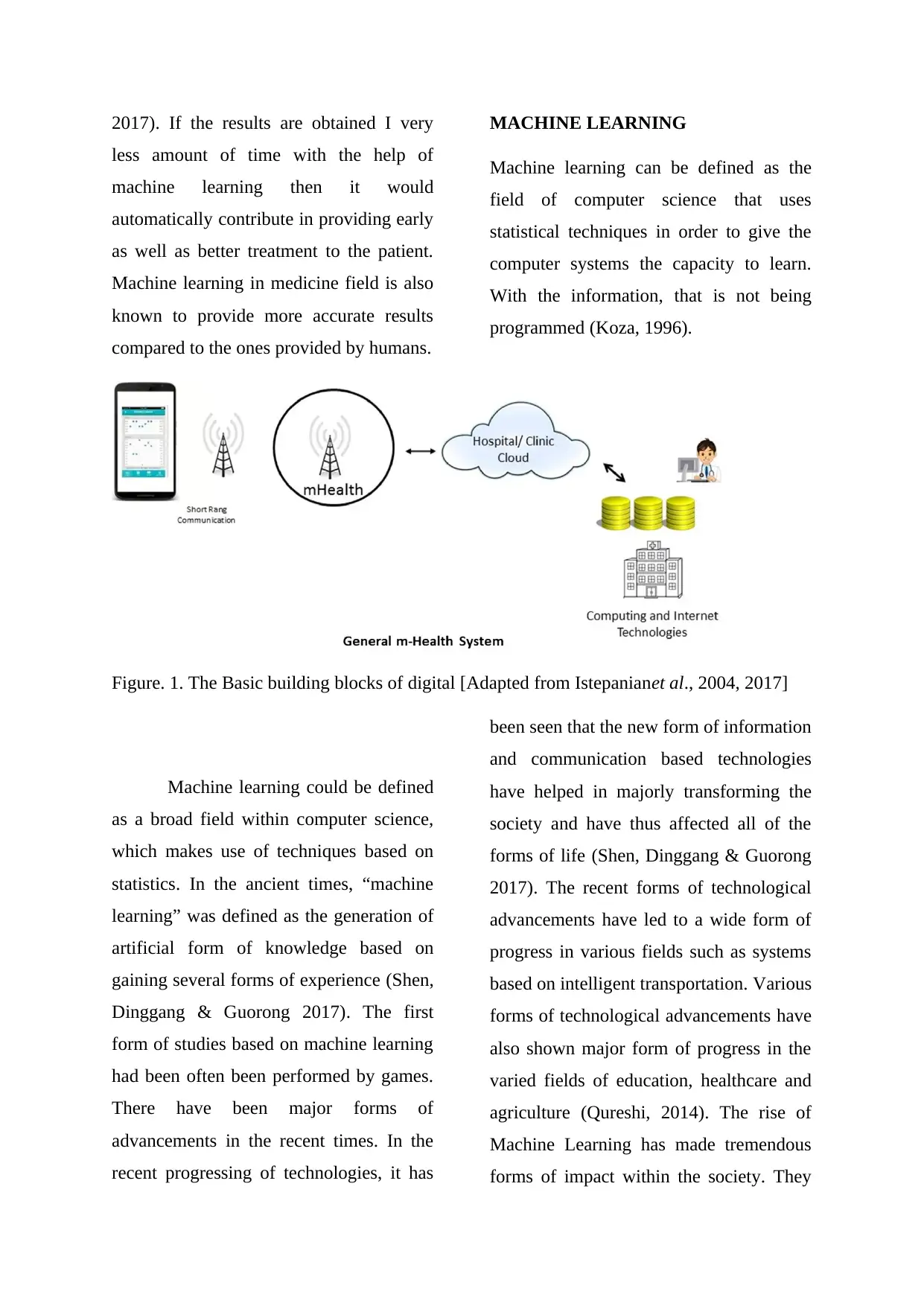
2017). If the results are obtained I very
less amount of time with the help of
machine learning then it would
automatically contribute in providing early
as well as better treatment to the patient.
Machine learning in medicine field is also
known to provide more accurate results
compared to the ones provided by humans.
MACHINE LEARNING
Machine learning can be defined as the
field of computer science that uses
statistical techniques in order to give the
computer systems the capacity to learn.
With the information, that is not being
programmed (Koza, 1996).
Figure. 1. The Basic building blocks of digital [Adapted from Istepanianet al., 2004, 2017]
Machine learning could be defined
as a broad field within computer science,
which makes use of techniques based on
statistics. In the ancient times, “machine
learning” was defined as the generation of
artificial form of knowledge based on
gaining several forms of experience (Shen,
Dinggang & Guorong 2017). The first
form of studies based on machine learning
had been often been performed by games.
There have been major forms of
advancements in the recent times. In the
recent progressing of technologies, it has
been seen that the new form of information
and communication based technologies
have helped in majorly transforming the
society and have thus affected all of the
forms of life (Shen, Dinggang & Guorong
2017). The recent forms of technological
advancements have led to a wide form of
progress in various fields such as systems
based on intelligent transportation. Various
forms of technological advancements have
also shown major form of progress in the
varied fields of education, healthcare and
agriculture (Qureshi, 2014). The rise of
Machine Learning has made tremendous
forms of impact within the society. They
less amount of time with the help of
machine learning then it would
automatically contribute in providing early
as well as better treatment to the patient.
Machine learning in medicine field is also
known to provide more accurate results
compared to the ones provided by humans.
MACHINE LEARNING
Machine learning can be defined as the
field of computer science that uses
statistical techniques in order to give the
computer systems the capacity to learn.
With the information, that is not being
programmed (Koza, 1996).
Figure. 1. The Basic building blocks of digital [Adapted from Istepanianet al., 2004, 2017]
Machine learning could be defined
as a broad field within computer science,
which makes use of techniques based on
statistics. In the ancient times, “machine
learning” was defined as the generation of
artificial form of knowledge based on
gaining several forms of experience (Shen,
Dinggang & Guorong 2017). The first
form of studies based on machine learning
had been often been performed by games.
There have been major forms of
advancements in the recent times. In the
recent progressing of technologies, it has
been seen that the new form of information
and communication based technologies
have helped in majorly transforming the
society and have thus affected all of the
forms of life (Shen, Dinggang & Guorong
2017). The recent forms of technological
advancements have led to a wide form of
progress in various fields such as systems
based on intelligent transportation. Various
forms of technological advancements have
also shown major form of progress in the
varied fields of education, healthcare and
agriculture (Qureshi, 2014). The rise of
Machine Learning has made tremendous
forms of impact within the society. They
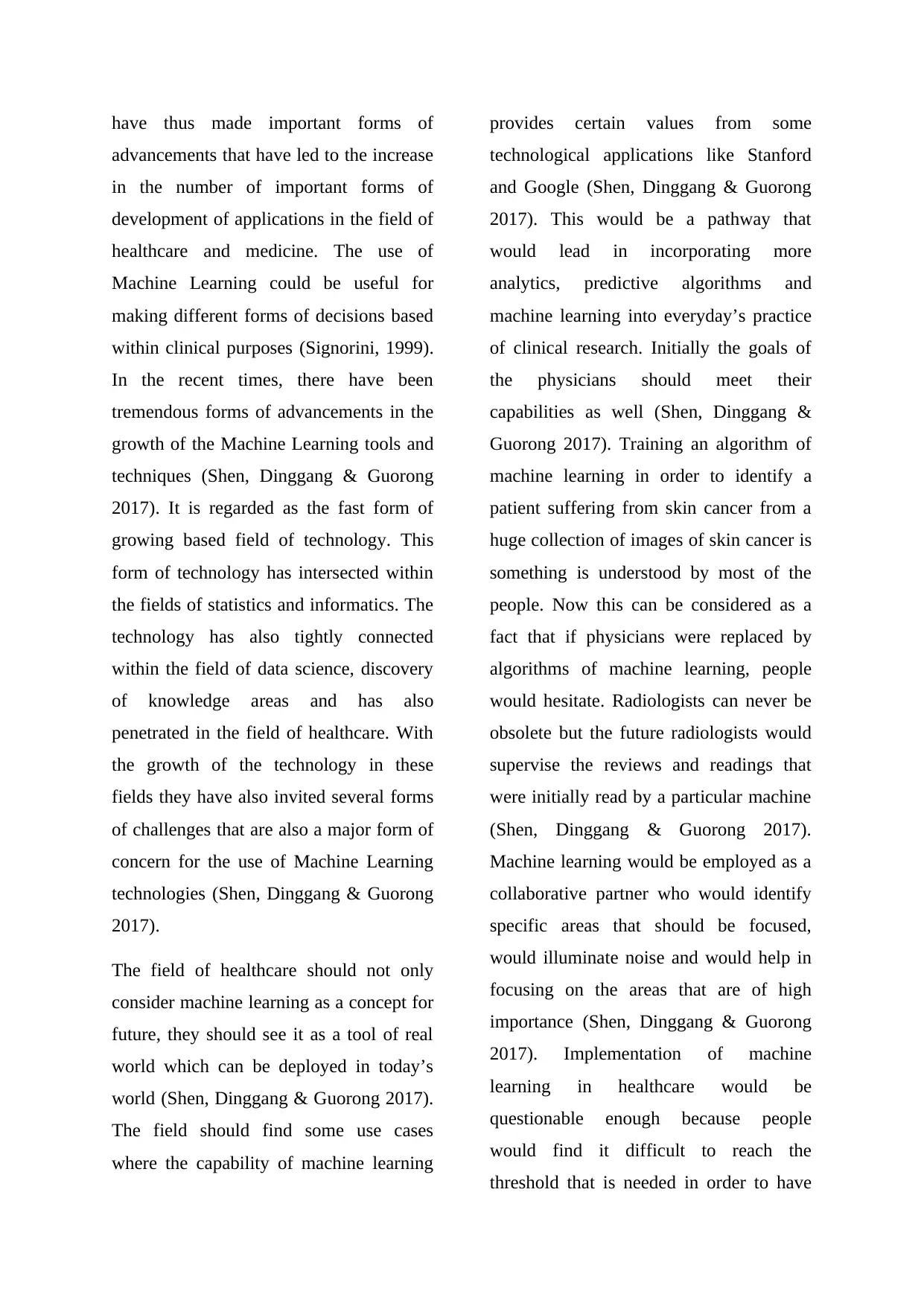
have thus made important forms of
advancements that have led to the increase
in the number of important forms of
development of applications in the field of
healthcare and medicine. The use of
Machine Learning could be useful for
making different forms of decisions based
within clinical purposes (Signorini, 1999).
In the recent times, there have been
tremendous forms of advancements in the
growth of the Machine Learning tools and
techniques (Shen, Dinggang & Guorong
2017). It is regarded as the fast form of
growing based field of technology. This
form of technology has intersected within
the fields of statistics and informatics. The
technology has also tightly connected
within the field of data science, discovery
of knowledge areas and has also
penetrated in the field of healthcare. With
the growth of the technology in these
fields they have also invited several forms
of challenges that are also a major form of
concern for the use of Machine Learning
technologies (Shen, Dinggang & Guorong
2017).
The field of healthcare should not only
consider machine learning as a concept for
future, they should see it as a tool of real
world which can be deployed in today’s
world (Shen, Dinggang & Guorong 2017).
The field should find some use cases
where the capability of machine learning
provides certain values from some
technological applications like Stanford
and Google (Shen, Dinggang & Guorong
2017). This would be a pathway that
would lead in incorporating more
analytics, predictive algorithms and
machine learning into everyday’s practice
of clinical research. Initially the goals of
the physicians should meet their
capabilities as well (Shen, Dinggang &
Guorong 2017). Training an algorithm of
machine learning in order to identify a
patient suffering from skin cancer from a
huge collection of images of skin cancer is
something is understood by most of the
people. Now this can be considered as a
fact that if physicians were replaced by
algorithms of machine learning, people
would hesitate. Radiologists can never be
obsolete but the future radiologists would
supervise the reviews and readings that
were initially read by a particular machine
(Shen, Dinggang & Guorong 2017).
Machine learning would be employed as a
collaborative partner who would identify
specific areas that should be focused,
would illuminate noise and would help in
focusing on the areas that are of high
importance (Shen, Dinggang & Guorong
2017). Implementation of machine
learning in healthcare would be
questionable enough because people
would find it difficult to reach the
threshold that is needed in order to have
advancements that have led to the increase
in the number of important forms of
development of applications in the field of
healthcare and medicine. The use of
Machine Learning could be useful for
making different forms of decisions based
within clinical purposes (Signorini, 1999).
In the recent times, there have been
tremendous forms of advancements in the
growth of the Machine Learning tools and
techniques (Shen, Dinggang & Guorong
2017). It is regarded as the fast form of
growing based field of technology. This
form of technology has intersected within
the fields of statistics and informatics. The
technology has also tightly connected
within the field of data science, discovery
of knowledge areas and has also
penetrated in the field of healthcare. With
the growth of the technology in these
fields they have also invited several forms
of challenges that are also a major form of
concern for the use of Machine Learning
technologies (Shen, Dinggang & Guorong
2017).
The field of healthcare should not only
consider machine learning as a concept for
future, they should see it as a tool of real
world which can be deployed in today’s
world (Shen, Dinggang & Guorong 2017).
The field should find some use cases
where the capability of machine learning
provides certain values from some
technological applications like Stanford
and Google (Shen, Dinggang & Guorong
2017). This would be a pathway that
would lead in incorporating more
analytics, predictive algorithms and
machine learning into everyday’s practice
of clinical research. Initially the goals of
the physicians should meet their
capabilities as well (Shen, Dinggang &
Guorong 2017). Training an algorithm of
machine learning in order to identify a
patient suffering from skin cancer from a
huge collection of images of skin cancer is
something is understood by most of the
people. Now this can be considered as a
fact that if physicians were replaced by
algorithms of machine learning, people
would hesitate. Radiologists can never be
obsolete but the future radiologists would
supervise the reviews and readings that
were initially read by a particular machine
(Shen, Dinggang & Guorong 2017).
Machine learning would be employed as a
collaborative partner who would identify
specific areas that should be focused,
would illuminate noise and would help in
focusing on the areas that are of high
importance (Shen, Dinggang & Guorong
2017). Implementation of machine
learning in healthcare would be
questionable enough because people
would find it difficult to reach the
threshold that is needed in order to have
⊘ This is a preview!⊘
Do you want full access?
Subscribe today to unlock all pages.

Trusted by 1+ million students worldwide
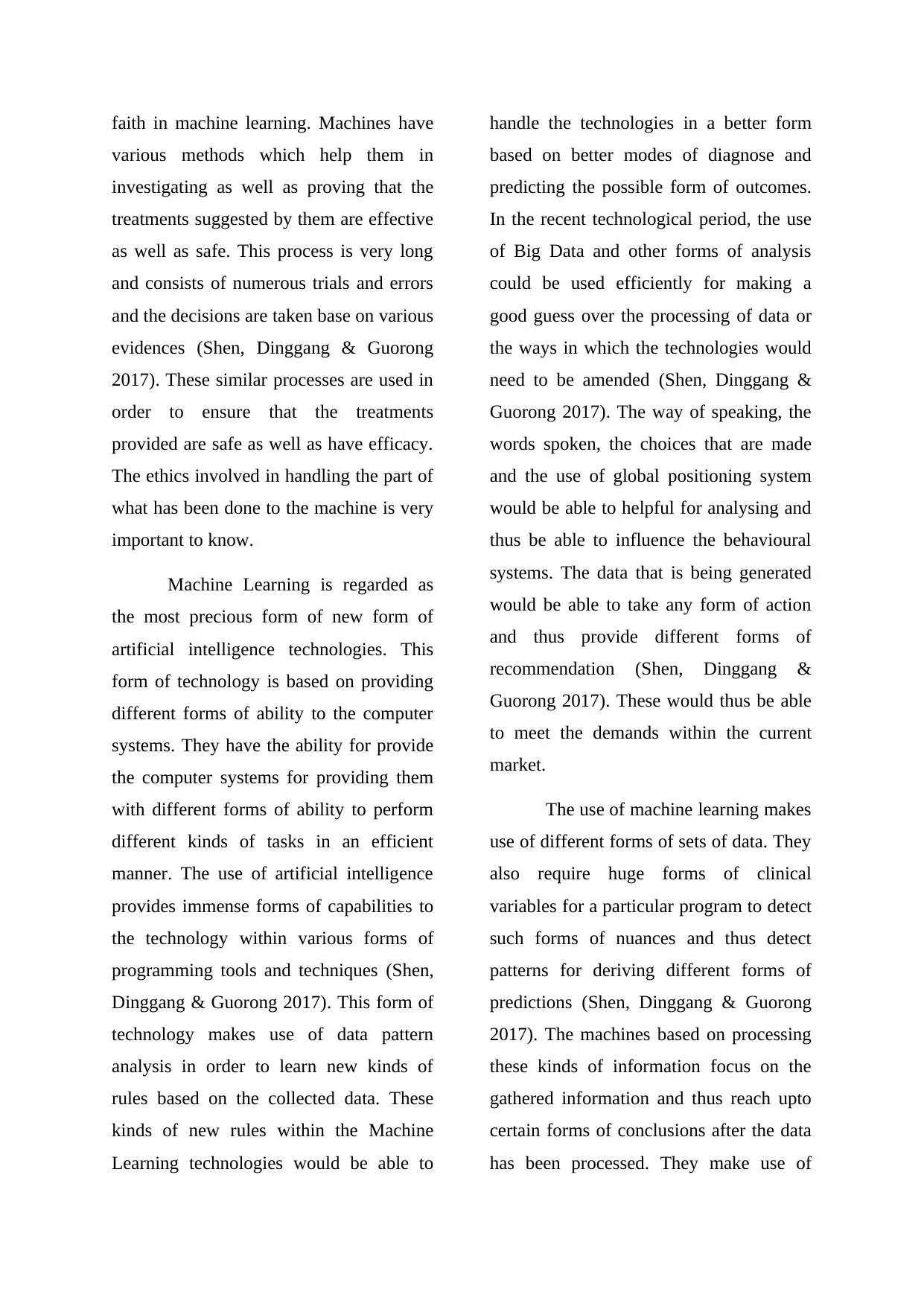
faith in machine learning. Machines have
various methods which help them in
investigating as well as proving that the
treatments suggested by them are effective
as well as safe. This process is very long
and consists of numerous trials and errors
and the decisions are taken base on various
evidences (Shen, Dinggang & Guorong
2017). These similar processes are used in
order to ensure that the treatments
provided are safe as well as have efficacy.
The ethics involved in handling the part of
what has been done to the machine is very
important to know.
Machine Learning is regarded as
the most precious form of new form of
artificial intelligence technologies. This
form of technology is based on providing
different forms of ability to the computer
systems. They have the ability for provide
the computer systems for providing them
with different forms of ability to perform
different kinds of tasks in an efficient
manner. The use of artificial intelligence
provides immense forms of capabilities to
the technology within various forms of
programming tools and techniques (Shen,
Dinggang & Guorong 2017). This form of
technology makes use of data pattern
analysis in order to learn new kinds of
rules based on the collected data. These
kinds of new rules within the Machine
Learning technologies would be able to
handle the technologies in a better form
based on better modes of diagnose and
predicting the possible form of outcomes.
In the recent technological period, the use
of Big Data and other forms of analysis
could be used efficiently for making a
good guess over the processing of data or
the ways in which the technologies would
need to be amended (Shen, Dinggang &
Guorong 2017). The way of speaking, the
words spoken, the choices that are made
and the use of global positioning system
would be able to helpful for analysing and
thus be able to influence the behavioural
systems. The data that is being generated
would be able to take any form of action
and thus provide different forms of
recommendation (Shen, Dinggang &
Guorong 2017). These would thus be able
to meet the demands within the current
market.
The use of machine learning makes
use of different forms of sets of data. They
also require huge forms of clinical
variables for a particular program to detect
such forms of nuances and thus detect
patterns for deriving different forms of
predictions (Shen, Dinggang & Guorong
2017). The machines based on processing
these kinds of information focus on the
gathered information and thus reach upto
certain forms of conclusions after the data
has been processed. They make use of
various methods which help them in
investigating as well as proving that the
treatments suggested by them are effective
as well as safe. This process is very long
and consists of numerous trials and errors
and the decisions are taken base on various
evidences (Shen, Dinggang & Guorong
2017). These similar processes are used in
order to ensure that the treatments
provided are safe as well as have efficacy.
The ethics involved in handling the part of
what has been done to the machine is very
important to know.
Machine Learning is regarded as
the most precious form of new form of
artificial intelligence technologies. This
form of technology is based on providing
different forms of ability to the computer
systems. They have the ability for provide
the computer systems for providing them
with different forms of ability to perform
different kinds of tasks in an efficient
manner. The use of artificial intelligence
provides immense forms of capabilities to
the technology within various forms of
programming tools and techniques (Shen,
Dinggang & Guorong 2017). This form of
technology makes use of data pattern
analysis in order to learn new kinds of
rules based on the collected data. These
kinds of new rules within the Machine
Learning technologies would be able to
handle the technologies in a better form
based on better modes of diagnose and
predicting the possible form of outcomes.
In the recent technological period, the use
of Big Data and other forms of analysis
could be used efficiently for making a
good guess over the processing of data or
the ways in which the technologies would
need to be amended (Shen, Dinggang &
Guorong 2017). The way of speaking, the
words spoken, the choices that are made
and the use of global positioning system
would be able to helpful for analysing and
thus be able to influence the behavioural
systems. The data that is being generated
would be able to take any form of action
and thus provide different forms of
recommendation (Shen, Dinggang &
Guorong 2017). These would thus be able
to meet the demands within the current
market.
The use of machine learning makes
use of different forms of sets of data. They
also require huge forms of clinical
variables for a particular program to detect
such forms of nuances and thus detect
patterns for deriving different forms of
predictions (Shen, Dinggang & Guorong
2017). The machines based on processing
these kinds of information focus on the
gathered information and thus reach upto
certain forms of conclusions after the data
has been processed. They make use of
Paraphrase This Document
Need a fresh take? Get an instant paraphrase of this document with our AI Paraphraser
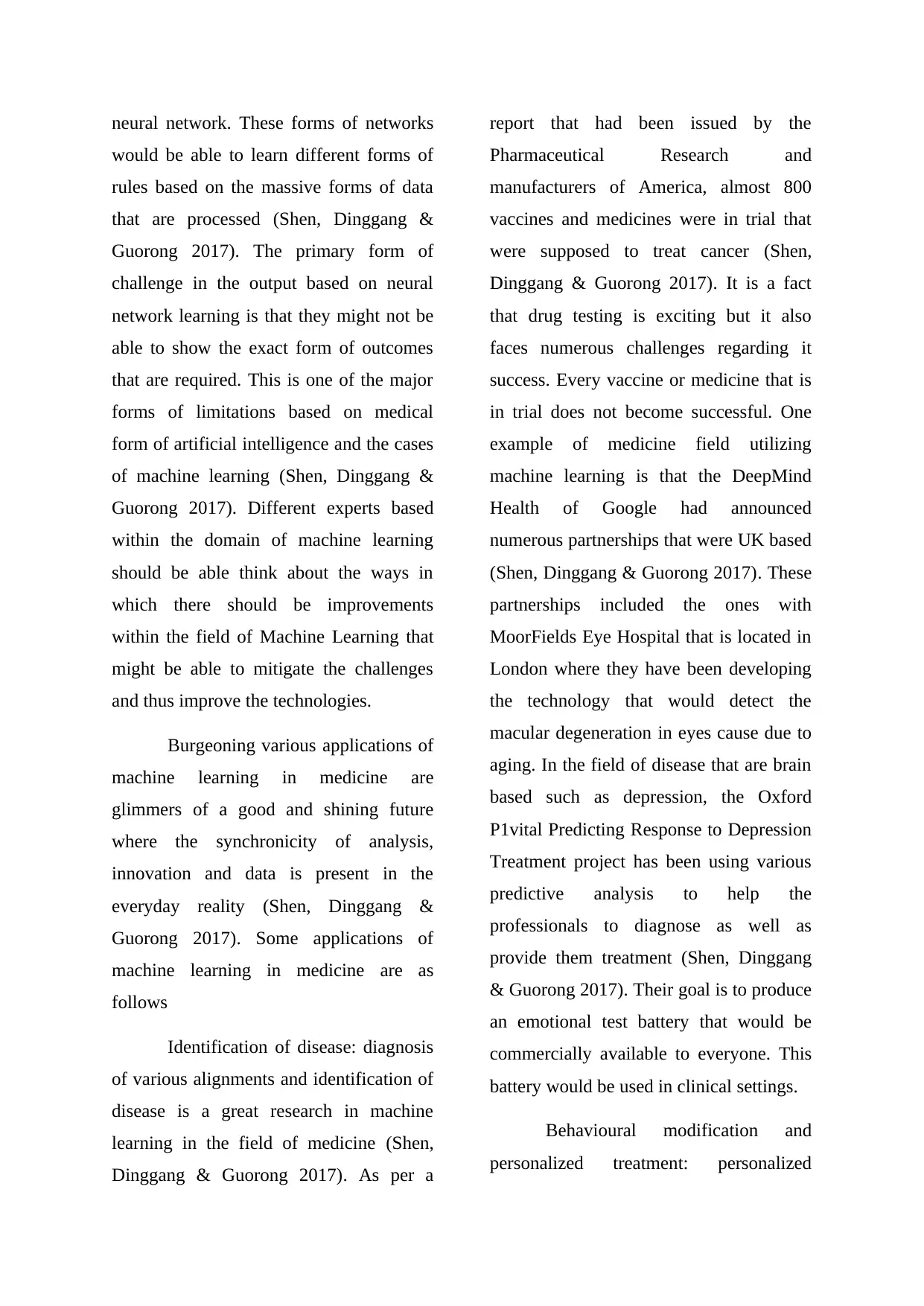
neural network. These forms of networks
would be able to learn different forms of
rules based on the massive forms of data
that are processed (Shen, Dinggang &
Guorong 2017). The primary form of
challenge in the output based on neural
network learning is that they might not be
able to show the exact form of outcomes
that are required. This is one of the major
forms of limitations based on medical
form of artificial intelligence and the cases
of machine learning (Shen, Dinggang &
Guorong 2017). Different experts based
within the domain of machine learning
should be able think about the ways in
which there should be improvements
within the field of Machine Learning that
might be able to mitigate the challenges
and thus improve the technologies.
Burgeoning various applications of
machine learning in medicine are
glimmers of a good and shining future
where the synchronicity of analysis,
innovation and data is present in the
everyday reality (Shen, Dinggang &
Guorong 2017). Some applications of
machine learning in medicine are as
follows
Identification of disease: diagnosis
of various alignments and identification of
disease is a great research in machine
learning in the field of medicine (Shen,
Dinggang & Guorong 2017). As per a
report that had been issued by the
Pharmaceutical Research and
manufacturers of America, almost 800
vaccines and medicines were in trial that
were supposed to treat cancer (Shen,
Dinggang & Guorong 2017). It is a fact
that drug testing is exciting but it also
faces numerous challenges regarding it
success. Every vaccine or medicine that is
in trial does not become successful. One
example of medicine field utilizing
machine learning is that the DeepMind
Health of Google had announced
numerous partnerships that were UK based
(Shen, Dinggang & Guorong 2017). These
partnerships included the ones with
MoorFields Eye Hospital that is located in
London where they have been developing
the technology that would detect the
macular degeneration in eyes cause due to
aging. In the field of disease that are brain
based such as depression, the Oxford
P1vital Predicting Response to Depression
Treatment project has been using various
predictive analysis to help the
professionals to diagnose as well as
provide them treatment (Shen, Dinggang
& Guorong 2017). Their goal is to produce
an emotional test battery that would be
commercially available to everyone. This
battery would be used in clinical settings.
Behavioural modification and
personalized treatment: personalized
would be able to learn different forms of
rules based on the massive forms of data
that are processed (Shen, Dinggang &
Guorong 2017). The primary form of
challenge in the output based on neural
network learning is that they might not be
able to show the exact form of outcomes
that are required. This is one of the major
forms of limitations based on medical
form of artificial intelligence and the cases
of machine learning (Shen, Dinggang &
Guorong 2017). Different experts based
within the domain of machine learning
should be able think about the ways in
which there should be improvements
within the field of Machine Learning that
might be able to mitigate the challenges
and thus improve the technologies.
Burgeoning various applications of
machine learning in medicine are
glimmers of a good and shining future
where the synchronicity of analysis,
innovation and data is present in the
everyday reality (Shen, Dinggang &
Guorong 2017). Some applications of
machine learning in medicine are as
follows
Identification of disease: diagnosis
of various alignments and identification of
disease is a great research in machine
learning in the field of medicine (Shen,
Dinggang & Guorong 2017). As per a
report that had been issued by the
Pharmaceutical Research and
manufacturers of America, almost 800
vaccines and medicines were in trial that
were supposed to treat cancer (Shen,
Dinggang & Guorong 2017). It is a fact
that drug testing is exciting but it also
faces numerous challenges regarding it
success. Every vaccine or medicine that is
in trial does not become successful. One
example of medicine field utilizing
machine learning is that the DeepMind
Health of Google had announced
numerous partnerships that were UK based
(Shen, Dinggang & Guorong 2017). These
partnerships included the ones with
MoorFields Eye Hospital that is located in
London where they have been developing
the technology that would detect the
macular degeneration in eyes cause due to
aging. In the field of disease that are brain
based such as depression, the Oxford
P1vital Predicting Response to Depression
Treatment project has been using various
predictive analysis to help the
professionals to diagnose as well as
provide them treatment (Shen, Dinggang
& Guorong 2017). Their goal is to produce
an emotional test battery that would be
commercially available to everyone. This
battery would be used in clinical settings.
Behavioural modification and
personalized treatment: personalized
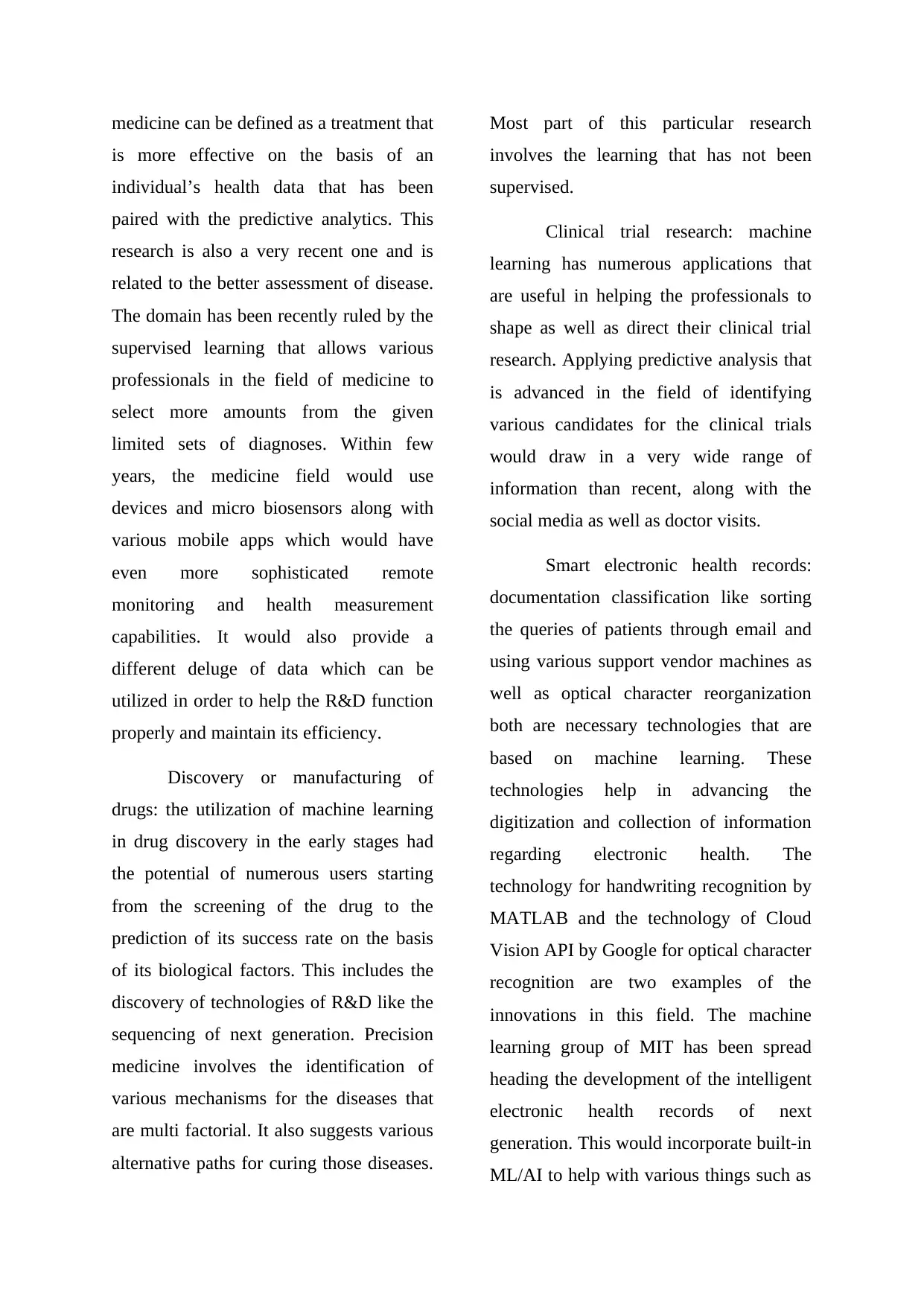
medicine can be defined as a treatment that
is more effective on the basis of an
individual’s health data that has been
paired with the predictive analytics. This
research is also a very recent one and is
related to the better assessment of disease.
The domain has been recently ruled by the
supervised learning that allows various
professionals in the field of medicine to
select more amounts from the given
limited sets of diagnoses. Within few
years, the medicine field would use
devices and micro biosensors along with
various mobile apps which would have
even more sophisticated remote
monitoring and health measurement
capabilities. It would also provide a
different deluge of data which can be
utilized in order to help the R&D function
properly and maintain its efficiency.
Discovery or manufacturing of
drugs: the utilization of machine learning
in drug discovery in the early stages had
the potential of numerous users starting
from the screening of the drug to the
prediction of its success rate on the basis
of its biological factors. This includes the
discovery of technologies of R&D like the
sequencing of next generation. Precision
medicine involves the identification of
various mechanisms for the diseases that
are multi factorial. It also suggests various
alternative paths for curing those diseases.
Most part of this particular research
involves the learning that has not been
supervised.
Clinical trial research: machine
learning has numerous applications that
are useful in helping the professionals to
shape as well as direct their clinical trial
research. Applying predictive analysis that
is advanced in the field of identifying
various candidates for the clinical trials
would draw in a very wide range of
information than recent, along with the
social media as well as doctor visits.
Smart electronic health records:
documentation classification like sorting
the queries of patients through email and
using various support vendor machines as
well as optical character reorganization
both are necessary technologies that are
based on machine learning. These
technologies help in advancing the
digitization and collection of information
regarding electronic health. The
technology for handwriting recognition by
MATLAB and the technology of Cloud
Vision API by Google for optical character
recognition are two examples of the
innovations in this field. The machine
learning group of MIT has been spread
heading the development of the intelligent
electronic health records of next
generation. This would incorporate built-in
ML/AI to help with various things such as
is more effective on the basis of an
individual’s health data that has been
paired with the predictive analytics. This
research is also a very recent one and is
related to the better assessment of disease.
The domain has been recently ruled by the
supervised learning that allows various
professionals in the field of medicine to
select more amounts from the given
limited sets of diagnoses. Within few
years, the medicine field would use
devices and micro biosensors along with
various mobile apps which would have
even more sophisticated remote
monitoring and health measurement
capabilities. It would also provide a
different deluge of data which can be
utilized in order to help the R&D function
properly and maintain its efficiency.
Discovery or manufacturing of
drugs: the utilization of machine learning
in drug discovery in the early stages had
the potential of numerous users starting
from the screening of the drug to the
prediction of its success rate on the basis
of its biological factors. This includes the
discovery of technologies of R&D like the
sequencing of next generation. Precision
medicine involves the identification of
various mechanisms for the diseases that
are multi factorial. It also suggests various
alternative paths for curing those diseases.
Most part of this particular research
involves the learning that has not been
supervised.
Clinical trial research: machine
learning has numerous applications that
are useful in helping the professionals to
shape as well as direct their clinical trial
research. Applying predictive analysis that
is advanced in the field of identifying
various candidates for the clinical trials
would draw in a very wide range of
information than recent, along with the
social media as well as doctor visits.
Smart electronic health records:
documentation classification like sorting
the queries of patients through email and
using various support vendor machines as
well as optical character reorganization
both are necessary technologies that are
based on machine learning. These
technologies help in advancing the
digitization and collection of information
regarding electronic health. The
technology for handwriting recognition by
MATLAB and the technology of Cloud
Vision API by Google for optical character
recognition are two examples of the
innovations in this field. The machine
learning group of MIT has been spread
heading the development of the intelligent
electronic health records of next
generation. This would incorporate built-in
ML/AI to help with various things such as
⊘ This is a preview!⊘
Do you want full access?
Subscribe today to unlock all pages.

Trusted by 1+ million students worldwide
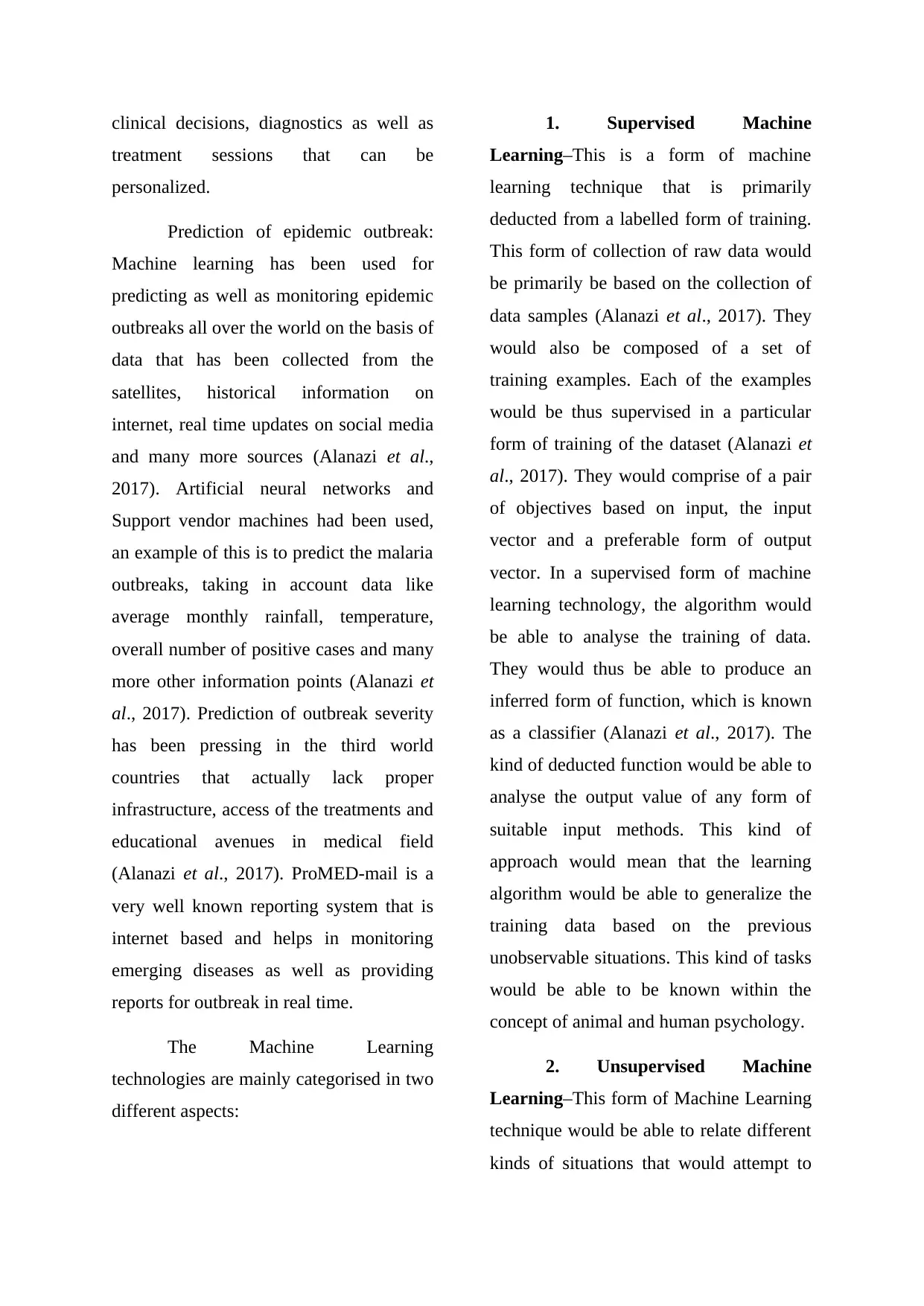
clinical decisions, diagnostics as well as
treatment sessions that can be
personalized.
Prediction of epidemic outbreak:
Machine learning has been used for
predicting as well as monitoring epidemic
outbreaks all over the world on the basis of
data that has been collected from the
satellites, historical information on
internet, real time updates on social media
and many more sources (Alanazi et al.,
2017). Artificial neural networks and
Support vendor machines had been used,
an example of this is to predict the malaria
outbreaks, taking in account data like
average monthly rainfall, temperature,
overall number of positive cases and many
more other information points (Alanazi et
al., 2017). Prediction of outbreak severity
has been pressing in the third world
countries that actually lack proper
infrastructure, access of the treatments and
educational avenues in medical field
(Alanazi et al., 2017). ProMED-mail is a
very well known reporting system that is
internet based and helps in monitoring
emerging diseases as well as providing
reports for outbreak in real time.
The Machine Learning
technologies are mainly categorised in two
different aspects:
1. Supervised Machine
Learning–This is a form of machine
learning technique that is primarily
deducted from a labelled form of training.
This form of collection of raw data would
be primarily be based on the collection of
data samples (Alanazi et al., 2017). They
would also be composed of a set of
training examples. Each of the examples
would be thus supervised in a particular
form of training of the dataset (Alanazi et
al., 2017). They would comprise of a pair
of objectives based on input, the input
vector and a preferable form of output
vector. In a supervised form of machine
learning technology, the algorithm would
be able to analyse the training of data.
They would thus be able to produce an
inferred form of function, which is known
as a classifier (Alanazi et al., 2017). The
kind of deducted function would be able to
analyse the output value of any form of
suitable input methods. This kind of
approach would mean that the learning
algorithm would be able to generalize the
training data based on the previous
unobservable situations. This kind of tasks
would be able to be known within the
concept of animal and human psychology.
2. Unsupervised Machine
Learning–This form of Machine Learning
technique would be able to relate different
kinds of situations that would attempt to
treatment sessions that can be
personalized.
Prediction of epidemic outbreak:
Machine learning has been used for
predicting as well as monitoring epidemic
outbreaks all over the world on the basis of
data that has been collected from the
satellites, historical information on
internet, real time updates on social media
and many more sources (Alanazi et al.,
2017). Artificial neural networks and
Support vendor machines had been used,
an example of this is to predict the malaria
outbreaks, taking in account data like
average monthly rainfall, temperature,
overall number of positive cases and many
more other information points (Alanazi et
al., 2017). Prediction of outbreak severity
has been pressing in the third world
countries that actually lack proper
infrastructure, access of the treatments and
educational avenues in medical field
(Alanazi et al., 2017). ProMED-mail is a
very well known reporting system that is
internet based and helps in monitoring
emerging diseases as well as providing
reports for outbreak in real time.
The Machine Learning
technologies are mainly categorised in two
different aspects:
1. Supervised Machine
Learning–This is a form of machine
learning technique that is primarily
deducted from a labelled form of training.
This form of collection of raw data would
be primarily be based on the collection of
data samples (Alanazi et al., 2017). They
would also be composed of a set of
training examples. Each of the examples
would be thus supervised in a particular
form of training of the dataset (Alanazi et
al., 2017). They would comprise of a pair
of objectives based on input, the input
vector and a preferable form of output
vector. In a supervised form of machine
learning technology, the algorithm would
be able to analyse the training of data.
They would thus be able to produce an
inferred form of function, which is known
as a classifier (Alanazi et al., 2017). The
kind of deducted function would be able to
analyse the output value of any form of
suitable input methods. This kind of
approach would mean that the learning
algorithm would be able to generalize the
training data based on the previous
unobservable situations. This kind of tasks
would be able to be known within the
concept of animal and human psychology.
2. Unsupervised Machine
Learning–This form of Machine Learning
technique would be able to relate different
kinds of situations that would attempt to
Paraphrase This Document
Need a fresh take? Get an instant paraphrase of this document with our AI Paraphraser
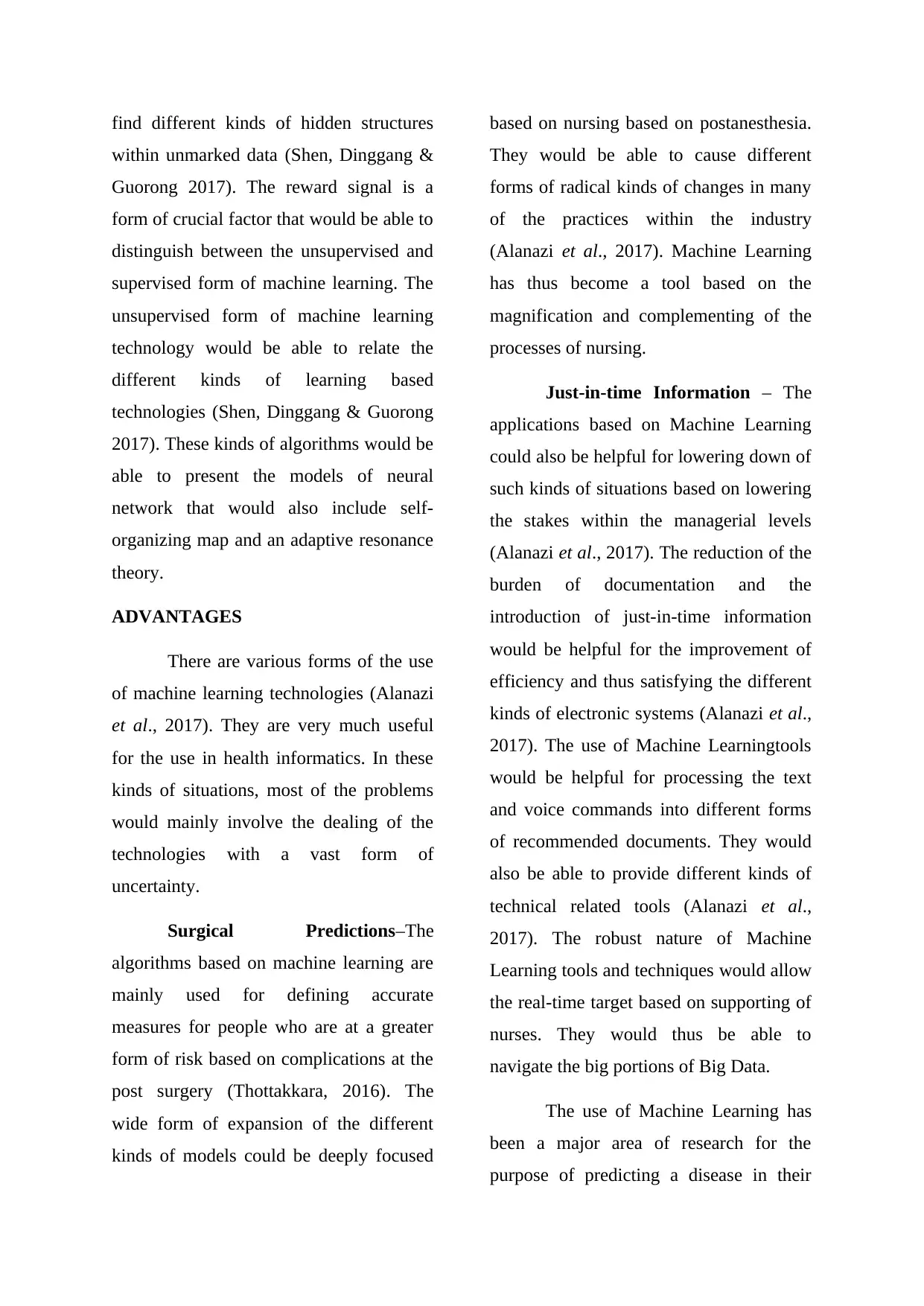
find different kinds of hidden structures
within unmarked data (Shen, Dinggang &
Guorong 2017). The reward signal is a
form of crucial factor that would be able to
distinguish between the unsupervised and
supervised form of machine learning. The
unsupervised form of machine learning
technology would be able to relate the
different kinds of learning based
technologies (Shen, Dinggang & Guorong
2017). These kinds of algorithms would be
able to present the models of neural
network that would also include self-
organizing map and an adaptive resonance
theory.
ADVANTAGES
There are various forms of the use
of machine learning technologies (Alanazi
et al., 2017). They are very much useful
for the use in health informatics. In these
kinds of situations, most of the problems
would mainly involve the dealing of the
technologies with a vast form of
uncertainty.
Surgical Predictions–The
algorithms based on machine learning are
mainly used for defining accurate
measures for people who are at a greater
form of risk based on complications at the
post surgery (Thottakkara, 2016). The
wide form of expansion of the different
kinds of models could be deeply focused
based on nursing based on postanesthesia.
They would be able to cause different
forms of radical kinds of changes in many
of the practices within the industry
(Alanazi et al., 2017). Machine Learning
has thus become a tool based on the
magnification and complementing of the
processes of nursing.
Just-in-time Information – The
applications based on Machine Learning
could also be helpful for lowering down of
such kinds of situations based on lowering
the stakes within the managerial levels
(Alanazi et al., 2017). The reduction of the
burden of documentation and the
introduction of just-in-time information
would be helpful for the improvement of
efficiency and thus satisfying the different
kinds of electronic systems (Alanazi et al.,
2017). The use of Machine Learningtools
would be helpful for processing the text
and voice commands into different forms
of recommended documents. They would
also be able to provide different kinds of
technical related tools (Alanazi et al.,
2017). The robust nature of Machine
Learning tools and techniques would allow
the real-time target based on supporting of
nurses. They would thus be able to
navigate the big portions of Big Data.
The use of Machine Learning has
been a major area of research for the
purpose of predicting a disease in their
within unmarked data (Shen, Dinggang &
Guorong 2017). The reward signal is a
form of crucial factor that would be able to
distinguish between the unsupervised and
supervised form of machine learning. The
unsupervised form of machine learning
technology would be able to relate the
different kinds of learning based
technologies (Shen, Dinggang & Guorong
2017). These kinds of algorithms would be
able to present the models of neural
network that would also include self-
organizing map and an adaptive resonance
theory.
ADVANTAGES
There are various forms of the use
of machine learning technologies (Alanazi
et al., 2017). They are very much useful
for the use in health informatics. In these
kinds of situations, most of the problems
would mainly involve the dealing of the
technologies with a vast form of
uncertainty.
Surgical Predictions–The
algorithms based on machine learning are
mainly used for defining accurate
measures for people who are at a greater
form of risk based on complications at the
post surgery (Thottakkara, 2016). The
wide form of expansion of the different
kinds of models could be deeply focused
based on nursing based on postanesthesia.
They would be able to cause different
forms of radical kinds of changes in many
of the practices within the industry
(Alanazi et al., 2017). Machine Learning
has thus become a tool based on the
magnification and complementing of the
processes of nursing.
Just-in-time Information – The
applications based on Machine Learning
could also be helpful for lowering down of
such kinds of situations based on lowering
the stakes within the managerial levels
(Alanazi et al., 2017). The reduction of the
burden of documentation and the
introduction of just-in-time information
would be helpful for the improvement of
efficiency and thus satisfying the different
kinds of electronic systems (Alanazi et al.,
2017). The use of Machine Learningtools
would be helpful for processing the text
and voice commands into different forms
of recommended documents. They would
also be able to provide different kinds of
technical related tools (Alanazi et al.,
2017). The robust nature of Machine
Learning tools and techniques would allow
the real-time target based on supporting of
nurses. They would thus be able to
navigate the big portions of Big Data.
The use of Machine Learning has
been a major area of research for the
purpose of predicting a disease in their
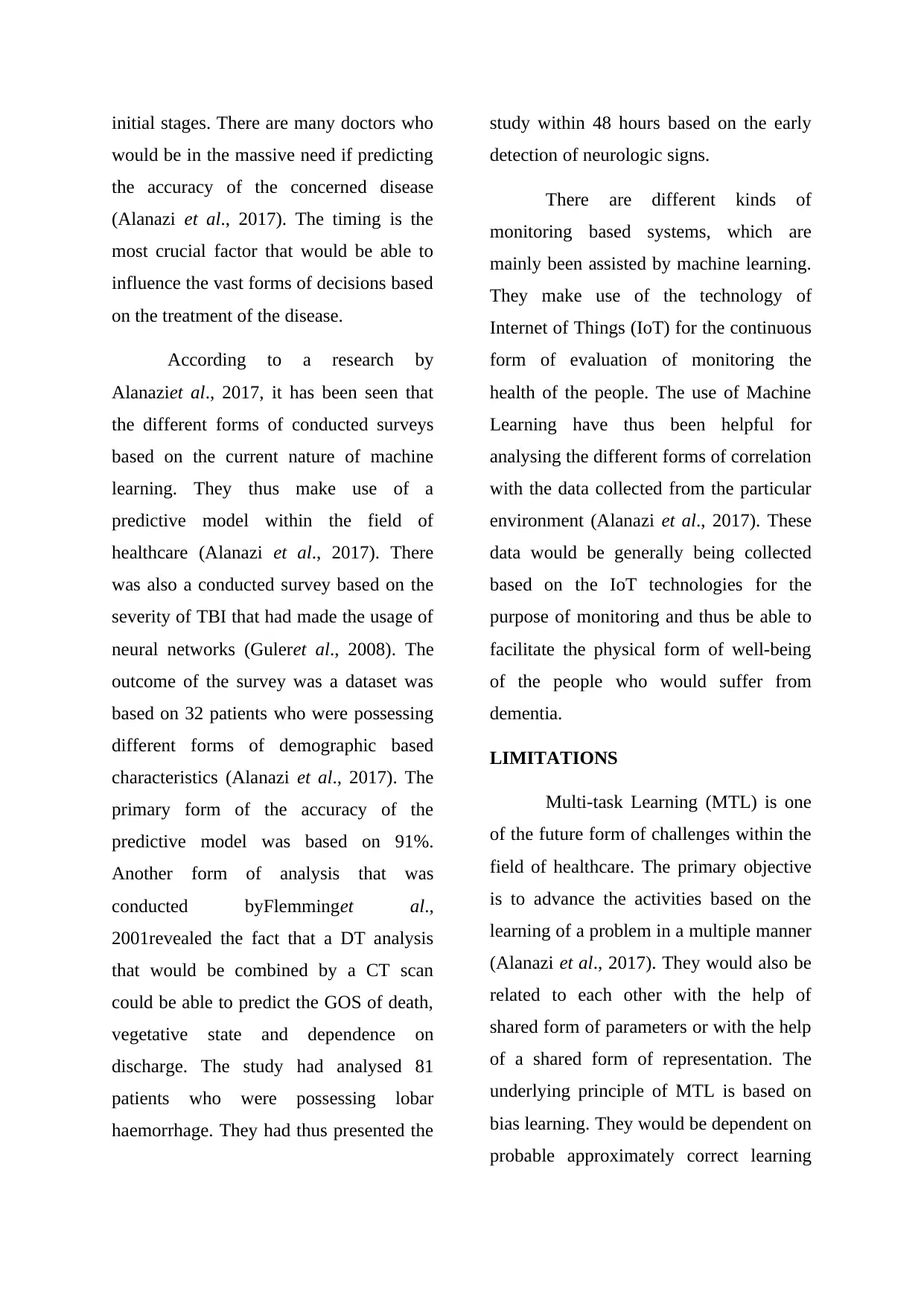
initial stages. There are many doctors who
would be in the massive need if predicting
the accuracy of the concerned disease
(Alanazi et al., 2017). The timing is the
most crucial factor that would be able to
influence the vast forms of decisions based
on the treatment of the disease.
According to a research by
Alanaziet al., 2017, it has been seen that
the different forms of conducted surveys
based on the current nature of machine
learning. They thus make use of a
predictive model within the field of
healthcare (Alanazi et al., 2017). There
was also a conducted survey based on the
severity of TBI that had made the usage of
neural networks (Guleret al., 2008). The
outcome of the survey was a dataset was
based on 32 patients who were possessing
different forms of demographic based
characteristics (Alanazi et al., 2017). The
primary form of the accuracy of the
predictive model was based on 91%.
Another form of analysis that was
conducted byFlemminget al.,
2001revealed the fact that a DT analysis
that would be combined by a CT scan
could be able to predict the GOS of death,
vegetative state and dependence on
discharge. The study had analysed 81
patients who were possessing lobar
haemorrhage. They had thus presented the
study within 48 hours based on the early
detection of neurologic signs.
There are different kinds of
monitoring based systems, which are
mainly been assisted by machine learning.
They make use of the technology of
Internet of Things (IoT) for the continuous
form of evaluation of monitoring the
health of the people. The use of Machine
Learning have thus been helpful for
analysing the different forms of correlation
with the data collected from the particular
environment (Alanazi et al., 2017). These
data would be generally being collected
based on the IoT technologies for the
purpose of monitoring and thus be able to
facilitate the physical form of well-being
of the people who would suffer from
dementia.
LIMITATIONS
Multi-task Learning (MTL) is one
of the future form of challenges within the
field of healthcare. The primary objective
is to advance the activities based on the
learning of a problem in a multiple manner
(Alanazi et al., 2017). They would also be
related to each other with the help of
shared form of parameters or with the help
of a shared form of representation. The
underlying principle of MTL is based on
bias learning. They would be dependent on
probable approximately correct learning
would be in the massive need if predicting
the accuracy of the concerned disease
(Alanazi et al., 2017). The timing is the
most crucial factor that would be able to
influence the vast forms of decisions based
on the treatment of the disease.
According to a research by
Alanaziet al., 2017, it has been seen that
the different forms of conducted surveys
based on the current nature of machine
learning. They thus make use of a
predictive model within the field of
healthcare (Alanazi et al., 2017). There
was also a conducted survey based on the
severity of TBI that had made the usage of
neural networks (Guleret al., 2008). The
outcome of the survey was a dataset was
based on 32 patients who were possessing
different forms of demographic based
characteristics (Alanazi et al., 2017). The
primary form of the accuracy of the
predictive model was based on 91%.
Another form of analysis that was
conducted byFlemminget al.,
2001revealed the fact that a DT analysis
that would be combined by a CT scan
could be able to predict the GOS of death,
vegetative state and dependence on
discharge. The study had analysed 81
patients who were possessing lobar
haemorrhage. They had thus presented the
study within 48 hours based on the early
detection of neurologic signs.
There are different kinds of
monitoring based systems, which are
mainly been assisted by machine learning.
They make use of the technology of
Internet of Things (IoT) for the continuous
form of evaluation of monitoring the
health of the people. The use of Machine
Learning have thus been helpful for
analysing the different forms of correlation
with the data collected from the particular
environment (Alanazi et al., 2017). These
data would be generally being collected
based on the IoT technologies for the
purpose of monitoring and thus be able to
facilitate the physical form of well-being
of the people who would suffer from
dementia.
LIMITATIONS
Multi-task Learning (MTL) is one
of the future form of challenges within the
field of healthcare. The primary objective
is to advance the activities based on the
learning of a problem in a multiple manner
(Alanazi et al., 2017). They would also be
related to each other with the help of
shared form of parameters or with the help
of a shared form of representation. The
underlying principle of MTL is based on
bias learning. They would be dependent on
probable approximately correct learning
⊘ This is a preview!⊘
Do you want full access?
Subscribe today to unlock all pages.

Trusted by 1+ million students worldwide
1 out of 16
Related Documents
Your All-in-One AI-Powered Toolkit for Academic Success.
+13062052269
info@desklib.com
Available 24*7 on WhatsApp / Email
![[object Object]](/_next/static/media/star-bottom.7253800d.svg)
Unlock your academic potential
Copyright © 2020–2025 A2Z Services. All Rights Reserved. Developed and managed by ZUCOL.





